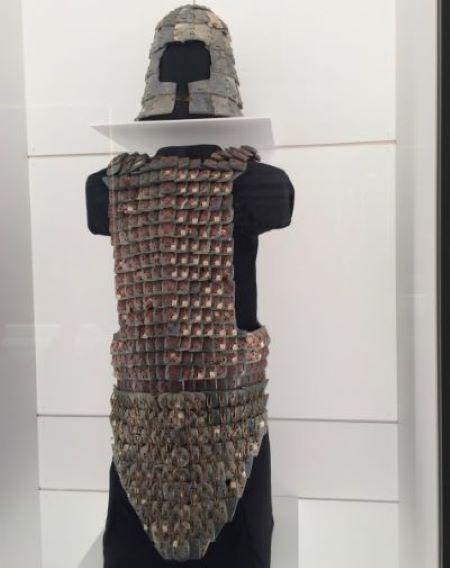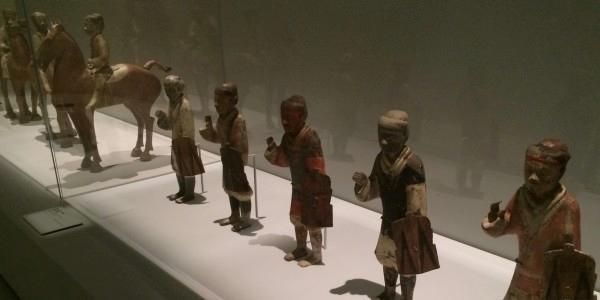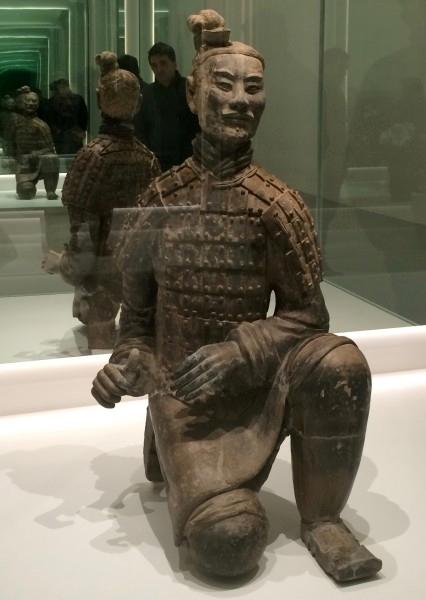The feature exhibition at the National Gallery of Victoria (NGV) in Melbourne is the Terracotta Warriors and Cai Guo-Qiang, combining ancient Chinese artifacts with brilliant artwork by Cai Guo-Qiang.
All the tomb warriors are individually made and when you take a closer look at each one, you can see each one displays its own personality.
In 1974, farmers in the Lintong District, Xian, in Shaanxi Provence were digging up a well looking for water and instead discovered the Terracotta Warriors. The head of a warrior was found first and it looked at the men with the most ferocious eyes. This find uncovered the tomb of Emperor Qin Shi Huang with his army of Terracotta Warriors that are guarding his immortality and journey to Heaven. No mention of these warriors was ever recorded in history and they remain a wondrous mystery of our time!
The first major exhibition outside China to Australia was in 1982, not long after the Warriors were found. This year is the fourth visit to Australia, with the Terracotta Warriors being accompanied by over 170 treasures from ancient China on display at the National Gallery of Victoria. These ancient artifacts show the culture, lifestyle, customs, and artistic skills that developed over the early Chinese dynasties. Items are from the Spring and Autumn period (771-475 B.C.), the Warring States period (475-221 B.C.), and the Qin Dynasty (221-207 B.C.). The ancient artifacts on display have been sourced from 20 different museums and collections in Shaanxi Province, China.

Han Dynasty earthenware pigments. Sourced from Ganquan County Museum, Yan’an. On display at NGV. (Image: via Trisha Haddock)
In ancient times, the Shaanxi area was known as Chang’an and it was the beginning of the Silk Road. Chang’an is known as the first ancient capital city in the world to hold 1 million people over 1,000 years ago. Today, Shaanxi Province is an area of China that is the heart of Chinese history, with more than a million years of human evolution situated there. Long ago, from the 11th century B.C. to the 10th century A.D., the Zhou, Qin, Han, Sui, Tang, and 14 other dynasties all chose Shaanxi Province as a place for their capital cities. The area of Shaanxi was once known as Qin; the name was derived from the Qin Empire.

From the Han Dynasty, a 4-sided flask that resembles Zhou Dynasty bronze vessels from 1,000 years earlier. Patterns relate to nature motifs, clouds, and dragons. Sourced from Ganquan County Museum. On display at NGV. (Image: via Trisha Haddock)
Ancient Chinese culture was enriched by a belief in Heaven, gods, deities, mystical creatures, and a strong inner knowing about the afterlife. Rituals were performed with objects that had jade, turquoise, and gold. Jade was considered to be a stone for longevity, purity, and immortality. Jade and gold together were known as a symbol of Heaven. Jade is known for its beauty, hardiness, its strength, and its musical capabilities. Jade was used in items for burial ceremonies, along with many other rituals.
Music was another way that enriched the lives of the ancient Chinese people. Music was well known to heal the heart and empower the mind. In the Shang Dynasty, sets of bells were used and in the Zhou Dynasty, bronze bells were made to perform at rituals, ceremonies, and special occasions. At the time of the Spring and Autumn period, the bell’s (also called bo) divine reverberant sounds and designs on them were perfected.

This is a panhui pattern and this type of intricate work is on the Duke of Qin’s bell that is on display at the NGV. (Image: via Trisha Haddock)
The bell on display is significant. It is believed the bell belonged to Duke Wu of Qin and it would have been used in ceremonies, rituals, and other festivities. Duke Wu of Qin’s bell has a unique shape, with an elaborate pattern that is known as panhui. Panhui is derived from the Kuilong pattern that has shapes based on auspicious mythical-homed dragons and serpents. Duke Wu of Qin died at the age of 21 (697-678 B.C.) He was a relative of the 1st emperor, being the 10th ruler of the Zhou Dynasty state of Qin, which ultimately united China and became the Qin Dynasty.
Over the Spring and Autumn and Warring States periods, the competition and rivalry among the Chinese people brought about structures like the regional court of grand palaces and more powerful infrastructure and advanced military technology. Also, this period started a trend of spoiling oneself by wearing lavish and rich clothing and ornaments. A lavish gold belt buckle once showed a person’s high status.
Disks with a hole inside from the Neolithic times are on display. They are made out of jade and similar disks were worn and also used as burial objects. Today, people still use disks in their homes, and similar small discs like these are worn as jewelry. The disks are believed to give wealth, longevity, and good health. Disks were important to the rulers of the Qin and Han dynasties and were used at the time when Confucius encouraged family life, peace, and harmony.

Qin Dynasty helmet and armor made out of stone pieces found in the tomb; this armor is not intended for a real battle. On display at the NGV. (Image: via Trisha Haddock)
The Chinese arrowheads give you an idea of the skilled Qin metalsmiths and the advanced technology of warfare. The arrowheads are crafted of two compounds that make the point — bronze and tin. The triangular tips are a high grade of tin and the shafts are made of a good grade of copper. This kind of arrowhead is sharper, more flexible, and less likely to deteriorate. Arrowheads represent the largest number of all the objects found in Emperor Qin Shihuang’s tomb. Hundreds of crossbow triggers, swords, lances, spears, halberds, and hooks were also found, including more than 40,000 arrowheads. They were gathered in bundles of 70, 100, and 114, with each bundle representing a bowman’s quiver.

Qin dynasty measuring vessel inscribed with two edicts. On display at NGV. (Image: via Trisha Haddock)
Ying Zheng announced himself to be China’s first emperor, naming himself Qin Shihuangdi. The Qin name comes from his original kingdom and Shi means the first. Huangdi evolves from three sovereigns and five emperors that made up the two groups of mythological rulers and deities of ancient China.
Once the many different lands were united, Emperor Qin’s role was to bring all the people in China together. People from different lands had their own ways of doing things. To unify the empire, new coins were made for all to use as money, and a standard measurement system was made; even a new dress code was introduced. Work was completed throughout the empire on new roads and new waterways for irrigation and the transport of produce. A new writing system was introduced that is similar to today’s Chinese writing.

Made from a western Han Dynasty hollow brick with two vermillion birds, on display at NGV. (Image: via Trisha Haddock)
Emperor Qin entombed with Terracotta Warriors
Emperor Qin died at the age of 49 on a trip to the Empire’s eastern regions, now known as Shandong Province. It is believed the Emperor had an obsession with immortality and may have swallowed too many poisonous potions that he believed would bring this to him. To avoid a fight over power, a horse and carriage carried the emperor’s body, along with fish to disguise the smell of the dead body, back to the palace. At the palace, he was placed into his tomb with his Terracotta Warriors and the artisans who knew all the secrets of the tomb, along with concubines and attendants.
Part of the mausoleum was excavated in the 1980s and they unearthed the mausoleum’s main area — the internal and exterior walls, main gates, scenic towers, and structures of the mausoleum. These discoveries opened up an understanding of how Emperor Qin Shihuang’s mausoleum site was laid out in sections. Recently, more unearthing of the tomb found the inner and outer palaces. Finding these gives us more knowledge about the formation of the mausoleum. Emperor Qin Shihuang’s main chamber where his body rests has not been touched.
The many artifacts found inside were placed in the tomb in sections of the main chamber, tomb passages, above the tomb structure, outer chamber, affiliated chamber, sacrificial altar, walls, gate towers, roads, mausoleum town, engineering facilities, and ancillary remains. Unearthing and finding other tombs revealed the Emperor’s harem and those affiliated with them. Then, as work continued, a 350,000 square meter space was discovered, which is three large sacrificial structure relics. This find gave an insight into the formation of the whole tomb.

Qin Dynasty chariot on display at NGV. The carriages were made out of wood and when found, they were crushed. Replicas were made and the original ones remain in China. (Image: via Trisha Haddock)
The Terracotta Warriors are situated in three pits on the outer palace wall of the mausoleum site. These pits are arranged in a way that the Qin army would have set up for a battle during its peak. The first pit is a rectangular shape with an area of 14,260 square meters. This pit contains 6,000 Terracotta Warriors and horses, 40 chariots, and over 100,000 bronze weapons. Pit two is placed at the end of pit one. Pit two is L-shaped and has an area of 6,000 square meters. An estimated nine chariots and horses, 116 terracotta horses with saddles, and over 900 Terracotta Warriors are buried here. Pit three is in the north of the west end of pit one and is U-shaped like the Chinese character ao. Its size is 524 square meters with an estimated one chariot, four terracotta horses, and 68 terracotta warriors. There is another pit between two and three, and it has been found in a state that does not look finished.

Qin Dynasty chariot on display at NGV. Carriages like this were known to be used in battle for the emporer to inspect his soldiers. Carriages on display at NGV. The two medium-sized horses and carriage were found in the tomb. (Image: via Trisha Haddock)

A mythical creature made from Eastern Han Dynasty stone. Walk between two mythical creatures like this toward the gate of the tomb. On display at the NGV. (Image: via Trisha Haddock)
When leaving the display of eight Terracotta Warriors, you then step between the mystical creatures guarding the gates. In this area, you will find small statues of an army and animals, and gates with a carved pattern in the stone. Emporer Qin Shuang’s tomb relics show his affiliation with the mythical rulers and deities of ancient China, conveying a firm impression of his supreme imperial mandate as the son of Heaven.

One part of the gates to the Emperor’s tomb depicts a scene with Fuxi and Nüwa. Ancient Chinese believe these two are the creators of humanity and are part of a group of deities called the Three Sovereigns. (Image: via Trisha Haddock)

On display at NGV, these tiny terracotta warriors were found in 1965 at Yangjawan. A terracotta army with more than 2,400 horses was found with riders and standing figures with shields. This site is believed to be a part of the burial complex of the first Han Emperor Guozu. (Image: via Trisha Haddock)
Cai Guo-Qiang uses the Chinese invention of gunpowder as his medium to create amazing artwork. Watch this video link to see how he creates his unique gunpowder art that comes to life with a bang!
This exhibition is on display at the National Gallery of Victoria now through October 13, 2019. It is a wondrous experience, so don’t miss out!
Written by Trisha Haddock
Follow us on Twitter, Facebook, or Pinterest







